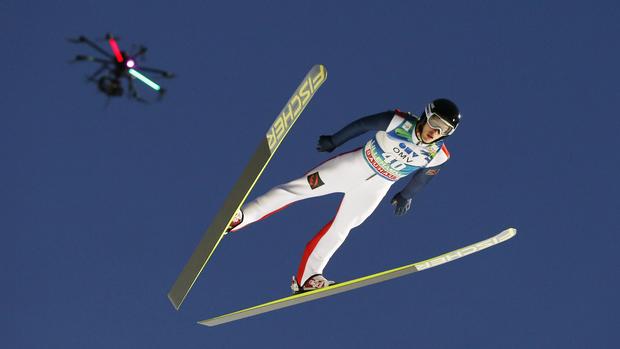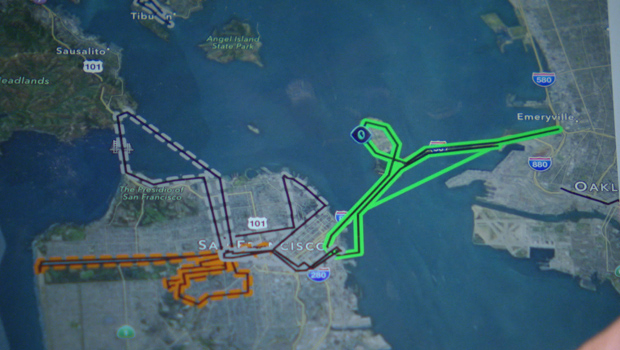The drone invasion now underway
Look ... UP IN THE SKY! Not a bird, not a plane ... it's a drone! Drones are everywhere, so much so that tomorrowthe Department of Transportation will announce a registration requirement for private drone ownership. It's expected to go into effect by Christmas. Of course, by then a lot more drones will be flying. Our Cover Story is reported now by David Pogue of Yahoo Tech:
Colorado farmer Greg Schreiner has a good eye for a good ear of corn. "In my opinion, that's a beautiful ear," he said, pulling off the husk.
This summer, his crops got help from a rather non-traditional farm implement: a drone -- a remote-controlled, flying robot with a camera.
Its pictures revealed a corn crisis: a dead zone that wasn't getting irrigated right in the middle of the field.
"Most of the field was green, and that was kind of a brownish black," Schreiner said. "We walked out into the field, walked into that area, found out that seven nozzles were clogged, which meant we weren't getting water on 37 acres. If we would have let it go, the potential was pretty huge for a loss."
That drone came from a company called Agribotix. "We're selling drones as fast as we can make them," said its founder, Tom McKinnon.
We've come a long way from military drones. Now there's a new crop of small, sophisticated drones that anyone can fly, and they're transforming all kinds of fields -- not just cornfields.
Filmmakers and photographers use them; they can get aerial shots where helicopters dare not go. Engineers use them to inspect utility lines and pipelines far away. Realtors take video of houses for sale -- and even fly through them. Law enforcement uses them to patrol borders.
A Belgian student even designed an ambulance drone that can deliver emergency equipment.
So how hard are they to fly, exactly? "Really simple," Randy Slavin, who owns an aerial cinematography company called Yeah Drones, told Pogue. "Even you can fly it."
Slavin, who is also the founder of the New York City Drone Film Festival, gave Pogue a little Driver's Ed with his $3,000 drone. Nothing to it!
So, drones ARE awesome! Drones ARE easy to fly! Drones ARE changing the world for the better!
Right?
Well, most of the time.
Drones also make headlines for the wrong reasons. Five people were injured a drone crashed into the crowd at the U.S. Open. A drone crashed into a tree on the South Lawn of the White House. And there have been more than a dozen cases of drones disrupting firefighting efforts.
- Drones pose new risks for firefighters battling California wildfires ("CBS Evening News," 08/11/15)
- Another drone crashes on White House grounds ("CBS This Morning," 10/09/15)
- Scare at U.S. Open as drone crashes into stands
They also make frightening flying weapons.
- Is teen's homemade "flying gun" illegal? ("CBS This Morning," 07/23/15)
And maybe scariest of all: drones could get in the way of airplanes.
- Sharp rise in close calls between drones and planes ("CBS This Morning," 08/13/15)
Clearly, there's a battle brewing. On one side, people who are excited about the enormous potential of drones; on the other, people who worry about noise, privacy and safety.
"We have the most complicated airspace in the world," said Secretary of Transportation Anthony Foxx. "And these new entrants, these unmanned aircraft would be just another layer of objects that we have flying in our airspace."
Foxx oversees the Federal Aviation Administration, which oversees the safety of our skies. The FAA has been working to come up with new rules to govern drones in America, but it hasn't been easy.
Pogue asked, "Can you characterize the two warring sides of the rule-making process?"
"Two sides?" replied Foxx. "There are a lot of sides to this one."
"And which side are you on?"
"I'm on the side of safety."
Foxx likens the arrival of drones to the dawn of the first automobiles. "All of a sudden, this new entrant is trying to occupy the same space as horse-drawn carriages. In some respects, that's where we are. We're trying to integrate this new use in a space that's been occupied by airplanes, helicopters, hobbyists and general aviation for so long."
The FAA distinguishes between flying a drone for fun, and flying one for money. Today, you're allowed to fly an amateur drone as long as you keep it five miles away from airports, below 400 feet, and within your sight.
You can fly a drone for commercial purposes only with special permission from the FAA.
But the FAA has proposed a new set of rules for commercial drones that would probably go into effect next year. A lot of companies are nervously watching to see how restrictive they're going to be -- especially Google and Amazon, which have huge plans to start delivering customer orders by drone.
Prime Air is a future delivery service that Paul Misener, in charge of public policy for Amazon, says will get packages to customers within 30 minutes of them ordering online at Amazon.com. And if the customer is not at home, "It gets delivered to your doorstep, or wherever you want -- in your yard -- just as like it would be if it were delivered by the UPS truck," said Misener.
Last year, Amazon made a video to show how Prime Air might work:
But the drones they're building and testing now are very different -- and still secret.
"These are highly automated drones that can take care of themselves in many respects," Misener said. "They have what is called 'sense-and-avoid technology.' That means, basically, seeing or detecting, and then avoiding obstacles."
Amazon is watching the FAA like a hawk. If the new rules wind up too restrictive, Amazon Prime Air might never get off the ground.
"What happens if the technology is ready, but the FAA. still doesn't have regulations in place for Amazon?" asked Pogue.
"We're going to be trying to deploy Prime Air everywhere we operate," said Misener. "So there's no reason why the United States must be first. We hope it is."
But here's the thing: Americans enjoy the world's safest air travel because we have a terrific air-traffic control system. Maybe the answer to the drone problem is right over our noses.
Parimal Kopardekar is in charge of NASA engineers who are working with the FAA to develop an air-traffic control system for drones.
How would it work? Say a filmmaker would like to fly along the Golden Gate Bridge and shoot that; what would he do?
"You can actually file your flight plan or a trajectory into the system and you could get that airspace reservation for that particular operation," said Kopardekar.
Engineer Thomas Prevot, head of NASA's Airspace Operations Laboratory, showed Pogue the simulations they've been doing on a new system, which is called UTM.
Operations plans, like flight plans, are loaded into the system. A pizza delivery over the Golden Gate Bridge was rejected because the Golden Gate Bridge is a national park.
"Here we have a Bay Bridge inspection, which is not going over a national park, and this operation got accepted within the system," said Prevot. "He has to stay within those dotted lines, and then the UTM system will make sure that nobody else is going to fly within those dotted lines at the same time."
NASA has started testing the system outside of the lab. "We have tried, and it works," laughed Prevot.
And not a moment too soon. The FAA predicts that a million drones will be sold this holiday season. What's their appeal?
Consider this year's winner of Randy Slavin's drone film festival, about Superman strapping a video camera to his head:
"It's super entertaining and amazing," Slevin said. "And still, every time I watch it, it gives me chills, to imagine what it would be like to be him, to fly on his shoulders or something."
And in the end, that's why drones are so irresistible. That's why they're our certain future. Because, come on, who wouldn't want to be Superman?
For more info:
- Agribotix
- Yeah Drones
- Follow videographer Randy Slavin on Vimeo
- New York City Drone Film Festival (March 4-6, 2016); Submissions open until December 19, 2015
- Follow the NYCDFF on Vimeo
- NASA Airspace Operations Laboratory
- knowbeforeyoufly.org
- 4 Rivers Equipment, Greeley, Colo.
- Silver Reef Organic Farms, Wellington, Colo.
- AeroVironment, Simi Valley, Calif.
- Birds Eye Aerial Drones


